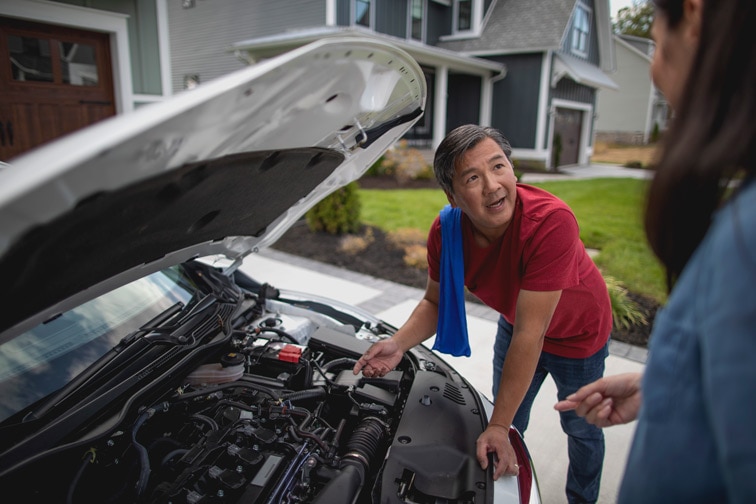Used-Car Buyers: Make Sure It’s All Good Under the Hood
Our targeted test drive can help you find a sweet ride—and steer clear of a lemon.

Updated on July 19, 2019
So you’ve found the perfect used car. It’s the right color, at the right price, and it’s loaded with your must-have extras. But what about the engine, transmission and brakes — you know, the parts that keep your car driving?
Believe it or not, you don’t have to be a mechanic to give your car a thorough examination (though you can certainly ask one to check out the vehicle, too). A targeted test drive, where you use your eyes, ears and a flashlight, can potentially save you thousands.
The Walk-Around: Bring a flashlight!
Every used car test drive should begin with a visual check. Pop the hood and turn on your flashlight, but don’t start the car yet. You’ll want the engine off to examine it.
- Engine: Shine your flashlight on every part of the engine. Any stains or “greasy” spots could mean something’s leaking. If the spot is covered in dirt, it’s been probably leaking for some time. Either way, point this out to the seller immediately.
Next, move to the belts at the front of the engine. On the inner side, you’ll notice thick rubber lines, or “tracks.” If the tracks are cracked or have gaps, they need to be replaced.
Finally, find the large, black hoses in front and give them a squeeze; they should be firm with no cracks. Also, make sure there’s no oil or fluid on them.
- Door and window seals: The rubber weather stripping around the vehicle’s windows and doors should be tight. No cracks, tears, or loose spots.
- Tires: Look closely at all four. Ideally, the tread should be worn evenly. If it isn’t, there could be alignment problems.
- Shocks: Also known as “struts,” shocks do more than give your car stability. They resist body roll, which means they help your car stop when you hit the brakes. Struts are filled with an oily fluid, and they have a bad habit of leaking as they age. Visible wet spots could mean the struts need to be replaced.
The Test Drive:
Starting the Car
A healthy car should only take a few seconds to start, and there shouldn’t be any squealing or grinding.
Before you put the car in gear, let it run, or idle, for 1-3 minutes. The engine needs to be warm to identify most problems. As it idles, look and listen for:
- Exhaust smoke or odor: Motor oil can leak into your engine and burn, emitting a white-blue smoke from the exhaust. Steam is normal, but burning oil creates noticeably thick smoke with a light-blue tint. It’s a serious problem, so be sure to stand a few feet behind the car to watch for it.
While you’re back there, take note of any smells. If you smell gasoline, bring it up with the seller immediately.
- In-dash warning lights: This includes the infamous “check engine light.” If any warning lights stay on as the car idles, check the owner’s manual (which should be in the glovebox) for a list of possible explanations.
- Suspicious sounds: You don’t want to hear grinding, squeaking, or ticking while the car idles.
If everything looks, sounds and smells normal, it’s time to put the car in gear and hit the road.
You May Also Like:
How to Keep Your Car Cool in the Summer
Say This, Not That at a Car Dealership
The 10 Best Cars for Teen Drivers, According to Science
Driving the Car
At some point during the test drive, pull off the road, roll down the windows and listen for noises from the engine. Again, you shouldn’t hear any grinding, squeaking, or ticking.
- Gear-shifting: In vehicles with automatic transmissions, you should be able to move smoothly between park, reverse, neutral and drive. Most automatic transmissions have at least 6 gears in “Drive” mode. Failing transmissions will cause the vehicle to “jerk” or “lunge” as it shifts from low to high gears, especially under 20 mph. If you experience these symptoms, bring it up with the seller.
- Steering: Listen closely for any noises while steering or turning. They could indicate failing steering components, a loss of steering fluid, or a bad engine belt.
- Braking: When it’s safe, roll down a window while braking and listen closely. (Brake noises are common, but if you hear excessive squeaking bring it up with the seller.) The brake pedal should be firm, but also reach the floor when you press hard enough. It should not vibrate under your foot—that’s a sign of worn or damaged brakes.
- Misfires: They can cause the car to “shiver” or “shudder” periodically while parked or stopped. Sometimes, a simple tune-up will fix a misfire, but it could also be a serious problem. If you notice the characteristic shivering at idle, bring it up with the seller.
If You’re Still Not Sure…
Friends or family members with car knowledge can be a great help; ask if they’re free to join you on the test drive. Most importantly, always ask to see a vehicle history report, such as Carfax. Reputable dealers will provide this information readily. If you’re still not sure, ask the seller if you can take the car to a mechanic before signing the paperwork. If they refuse, that could be a serious red flag.
Final Thoughts
Don’t feel guilty about thoroughly inspecting a used car, asking detailed questions, or even taking it to a mechanic. It’s your money, and you have every right to make sure you’re spending it on a truly sweet ride.
TARGETED TEST DRIVE: A CHECKLIST
Take this with you on the test drive.Step 1: The Walk-Around
You'll need a flashlight, the hood open, and the engine off.
Step 2: Starting & Driving the Car
Allow the car to warm up for about 3 minutes before driving.
Written by humans.
Edited by humans.
 Nick Say
Nick SayWhen I'm not writing, you’ll probably find me tinkering with my car. I started turning wrenches at 16, and worked at an auto shop while studying journalism in college. Now at Capital One, I combine my two favorite things—writing and cars.
Related articles
View more related articles